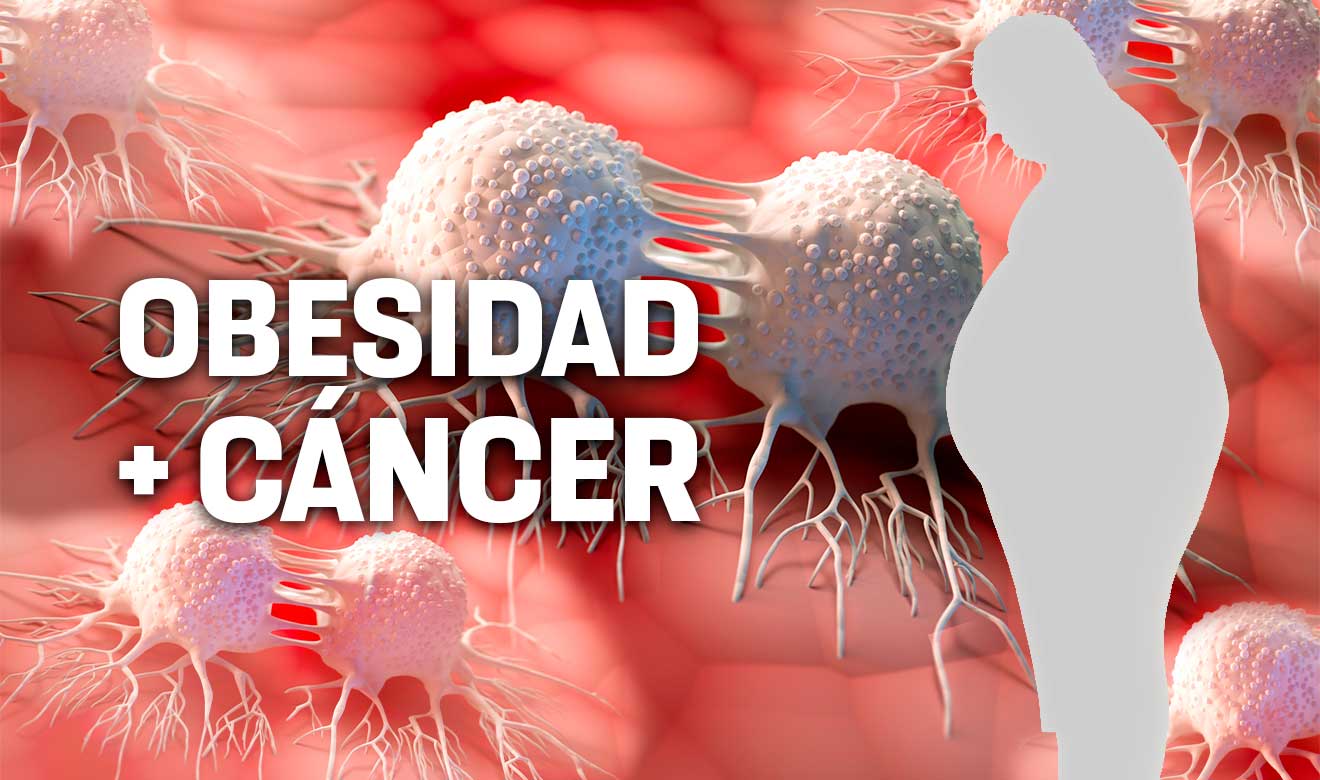Is there a relationship between Cancer and obesity?
DOI:
https://doi.org/10.36790/epistemus.v18i35.297Keywords:
cancer, inflammatory cytokines, inflammationAbstract
Obesity has become a pandemic around the world in recent years, along with by devastating diseases such as cancer. Recently, the relationship between obesity and overweight in cancer incidence has been investigated. Keywords such as inflammatory cytokines, obesity, cancer and inflammation were used to carry on a bibliographic search in the Worldwide Science, Springer Link, PubMed and Google Scholar databases to describe the relationship between obesity and cancer. Reported studies have been able to establish the connection between obesity and increased risk of different types of cancer. It has been reported that a change in lifestyle and diet can prevent 30 to 50% of diseases. It is important raise awareness on the fact that obesity is the second preventable cause of cancer and that a reduction in body mass, as well as avoiding weight gain in adulthood, reduces the risk of developing the disease.
Downloads
References
K. C. Zalesin, B. A. Franklin, W. M. Miller, E. D. Peterson, and P. A. McCullough, “Impact of Obesity on Cardiovascular Disease,” Endocrinol Metab Clin North Am, vol. 37, no. 3, pp. 663–684, Sep. 2008, doi: 10.1016/j.ecl.2008.06.004. DOI: https://doi.org/10.1016/j.ecl.2008.06.004
S. Tewari, R. Vargas, and O. Reizes, “The impact of obesity and adipokines on breast and gynecologic malignancies,” Ann N Y Acad Sci, vol. 1518, no. 1, pp. 131–150, Dec. 2022, doi: 10.1111/nyas.14916. DOI: https://doi.org/10.1111/nyas.14916
K. I. Avgerinos, N. Spyrou, C. S. Mantzoros, and M. Dalamaga, “Obesity and cancer risk: Emerging biological mechanisms and perspectives,” Metabolism, vol. 92, pp. 121–135, Mar. 2019, doi: 10.1016/j.metabol.2018.11.001. DOI: https://doi.org/10.1016/j.metabol.2018.11.001
OMS, “Organización Mundial de la Salud.,” 2022, Accessed: May 27, 2023. [Online]. Available: https://www.who.int/es/news-room/fact-sheets/detail/cancer
N. Singh, D. Baby, J. Rajguru, P. Patil, S. Thakkannavar, and V. Pujari, “Inflammation and cancer,” Ann Afr Med, vol. 18, no. 3, p. 121, 2019, doi: 10.4103/aam.aam_56_18. DOI: https://doi.org/10.4103/aam.aam_56_18
INEGI, “Estadísticas a propósito del día mundial contra el cáncer,” pp. 1–6, 2023, Accessed: May 02, 2023. [Online]. Available: https://www.inegi.org.mx/contenidos/saladeprensa/aproposito/2023/EAP_Cancer.pdf
S. H. Guadamuz Hernández and G. S. Brenes, “Generalidades de la obesidad sarcopénica en adultos mayores Generalities of sarcopenic obesity in older adults,” Costa Rica, Nov. 2020.
T. N. Kim, “Elderly Obesity: Is It Harmful or Beneficial?,” J Obes Metab Syndr, vol. 27, no. 2, pp. 84–92, Jun. 2018, doi: 10.7570/jomes.2018.27.2.84. DOI: https://doi.org/10.7570/jomes.2018.27.2.84
R. Pujia et al., “Advances in Phenotyping Obesity and in Its Dietary and Pharmacological Treatment: A Narrative Review,” Front Nutr, vol. 9, Feb. 2022, doi: 10.3389/fnut.2022.804719.
C. M. Hales, M. D. Carroll, C. D. Fryar, and C. L. Ogden, “Prevalence of Obesity and Severe Obesity Among Adults: United States, 2017-2018.,” NCHS Data Brief, no. 360, pp. 1–8, Feb. 2020.
“Mexico | World Obesity Federation Global Obesity Observatory.,” 2022, Accessed: May 09, 2023. [Online]. Available: https://data.worldobesity.org/country/mexico-139/
R. P. Garrido-Chamorro, J. E. Sirvent-Belando, M. Gonzalez-Lorenzo, M. L. Martin-Carratala, and E. Roche, “Correlation between body mass index and body composition in elite athletes.,” J Sports Med Phys Fitness, vol. 49, no. 3, pp. 278–84, Sep. 2009.
R. Pujia et al., “Advances in Phenotyping Obesity and in Its Dietary and Pharmacological Treatment: A Narrative Review,” Front Nutr, vol. 9, Feb. 2022, doi: 10.3389/fnut.2022.804719. DOI: https://doi.org/10.3389/fnut.2022.804719
A. De Lorenzo, R. Martinoli, F. Vaia, and L. Di Renzo, “Normal weight obese (NWO) women: An evaluation of a candidate new syndrome,” Nutrition, Metabolism and Cardiovascular Diseases, vol. 16, no. 8, pp. 513–523, Dec. 2006, doi: 10.1016/j.numecd.2005.10.010. DOI: https://doi.org/10.1016/j.numecd.2005.10.010
N. Ruderman, D. Chisholm, X. Pi-Sunyer, and S. Schneider, “The metabolically obese, normal-weight individual revisited.,” Diabetes, vol. 47, no. 5, pp. 699–713, May 1998, doi: 10.2337/diabetes.47.5.699. DOI: https://doi.org/10.2337/diabetes.47.5.699
Z. Zhou et al., “Are people with metabolically healthy obesity really healthy? A prospective cohort study of 381,363 UK Biobank participants,” Diabetologia, vol. 64, no. 9, pp. 1963–1972, Sep. 2021, doi: 10.1007/s00125-021-05484-6. DOI: https://doi.org/10.1007/s00125-021-05484-6
Y. Zhang, R. Proenca, M. Maffei, M. Barone, L. Leopold, and J. M. Friedman, “Positional cloning of the mouse obese gene and its human homologue,” Nature, vol. 372, no. 6505, pp. 425–432, Dec. 1994, doi: 10.1038/372425a0. DOI: https://doi.org/10.1038/372425a0
K. S. Cook et al., “Adipsin: A Circulating Serine Protease Homolog Secreted by Adipose Tissue and Sciatic Nerve,” Science (1979), vol. 237, no. 4813, pp. 402–405, Jul. 1987, doi: 10.1126/science.3299705. DOI: https://doi.org/10.1126/science.3299705
K. M. Nieman, I. L. Romero, B. Van Houten, and E. Lengyel, “Adipose tissue and adipocytes support tumorigenesis and metastasis,” Biochimica et Biophysica Acta (BBA) - Molecular and Cell Biology of Lipids, vol. 1831, no. 10, pp. 1533–1541, Oct. 2013, doi: 10.1016/j.bbalip.2013.02.010. DOI: https://doi.org/10.1016/j.bbalip.2013.02.010
N. Ouchi, J. L. Parker, J. J. Lugus, and K. Walsh, “Adipokines in inflammation and metabolic disease,” Nat Rev Immunol, vol. 11, no. 2, pp. 85–97, Feb. 2011, doi: 10.1038/nri2921. DOI: https://doi.org/10.1038/nri2921
K. K. Crean-Tate and O. Reizes, “Leptin Regulation of Cancer Stem Cells in Breast and Gynecologic Cancer,” Endocrinology, vol. 159, no. 8, pp. 3069–3080, Aug. 2018, doi: 10.1210/en.2018-00379. DOI: https://doi.org/10.1210/en.2018-00379
C. Saygin, D. Matei, R. Majeti, O. Reizes, and J. D. Lathia, “Targeting Cancer Stemness in the Clinic: From Hype to Hope,” Cell Stem Cell, vol. 24, no. 1, pp. 25–40, Jan. 2019, doi: 10.1016/j.stem.2018.11.017. DOI: https://doi.org/10.1016/j.stem.2018.11.017
T. Reya, S. J. Morrison, M. F. Clarke, and I. L. Weissman, “Stem cells, cancer, and cancer stem cells,” Nature, vol. 414, no. 6859, pp. 105–111, Nov. 2001, doi: 10.1038/35102167. DOI: https://doi.org/10.1038/35102167
J. M. Han and M. K. Levings, “Immune Regulation in Obesity-Associated Adipose Inflammation,” The Journal of Immunology, vol. 191, no. 2, pp. 527–532, Jul. 2013, doi: 10.4049/jimmunol.1301035. DOI: https://doi.org/10.4049/jimmunol.1301035
V. Kumar, J. Aster, N. Fausto, and A. Abbas, Robbins y Cotran. Patología estructural y funcional, 10th ed. Philadelphia: Elsevier Saunders, 2021.
D. Yazıcı and H. Sezer, “Insulin Resistance, Obesity and Lipotoxicity,” 2017, pp. 277–304. doi: 10.1007/978-3-319-48382-5_12. DOI: https://doi.org/10.1007/978-3-319-48382-5_12
L. Zhang and X.-M. Fan, “The pathological role of microRNAs and inflammation in colon carcinogenesis,” Clin Res Hepatol Gastroenterol, vol. 39, no. 2, pp. 174–179, Apr. 2015, doi: 10.1016/j.clinre.2014.06.013. DOI: https://doi.org/10.1016/j.clinre.2014.06.013
A. B. Porcaro et al., “Prostate Volume Index and Chronic Inflammation of the Prostate Type IV with Respect to the Risk of Prostate Cancer,” Urol Int, vol. 94, no. 3, pp. 270–285, 2015, doi: 10.1159/000362176. DOI: https://doi.org/10.1159/000362176
H. Yu, M. R. Spitz, J. Mistry, J. Gu, W. K. Hong, and X. Wu, “Plasma Levels of Insulin-Like Growth Factor-I and Lung Cancer Risk: a Case-Control Analysis,” JNCI Journal of the National Cancer Institute, vol. 91, no. 2, pp. 151–156, Jan. 1999, doi: 10.1093/jnci/91.2.151. DOI: https://doi.org/10.1093/jnci/91.2.151
A. Pariente and S. Erlinger, “ Lithiase biliaire et obésité : épidémiologie, physiopathologie, manifestations cliniques et prévention.,” 2017.
S. Lambou-Gianoukos and S. J. Heller, “Lithogenesis and Bile Metabolism,” Surgical Clinics of North America, vol. 88, no. 6, pp. 1175–1194, Dec. 2008, doi: 10.1016/j.suc.2008.07.009. DOI: https://doi.org/10.1016/j.suc.2008.07.009
G. Randi, S. Franceschi, and C. La Vecchia, “Gallbladder cancer worldwide: Geographical distribution and risk factors,” Int J Cancer, vol. 118, no. 7, pp. 1591–1602, Apr. 2006, doi: 10.1002/ijc.21683. DOI: https://doi.org/10.1002/ijc.21683
T. Schnelldorfer, “Porcelain Gallbladder: A Benign Process or Concern for Malignancy?,” Journal of Gastrointestinal Surgery, vol. 17, no. 6, pp. 1161–1168, Jun. 2013, doi: 10.1007/s11605-013-2170-0. DOI: https://doi.org/10.1007/s11605-013-2170-0
M. Scarpa, “Inflammatory colonic carcinogenesis: A review on pathogenesis and immunosurveillance mechanisms in ulcerative colitis,” World J Gastroenterol, vol. 20, no. 22, p. 6774, 2014, doi: 10.3748/wjg.v20.i22.6774. DOI: https://doi.org/10.3748/wjg.v20.i22.6774
S. P. Weisberg, D. McCann, M. Desai, M. Rosenbaum, R. L. Leibel, and A. W. Ferrante, “Obesity is associated with macrophage accumulation in adipose tissue,” Journal of Clinical Investigation, vol. 112, no. 12, pp. 1796–1808, Dec. 2003, doi: 10.1172/JCI19246. DOI: https://doi.org/10.1172/JCI200319246
F. Sánchez-Jiménez, A. Pérez-Pérez, L. de la Cruz-Merino, and V. Sánchez-Margalet, “Obesity and Breast Cancer: Role of Leptin,” Front Oncol, vol. 9, Jul. 2019, doi: 10.3389/fonc.2019.00596. DOI: https://doi.org/10.3389/fonc.2019.00596
F. Sanchez-Muñoz, R. García-Macedo, F. Alarcon-Aguilar, and M. Cruz, “Adipocinas, tejido adiposo y su relación con células del sistema inmune,” Gaceta Medica México, vol. 141, no. 6, pp. 505–512, Aug. 2005.
B. Dubern and K. Clement, “Leptin and leptin receptor-related monogenic obesity,” Biochimie, vol. 94, no. 10, pp. 2111–2115, Oct. 2012, doi: 10.1016/j.biochi.2012.05.010. DOI: https://doi.org/10.1016/j.biochi.2012.05.010
C. K. Shiba et al., “Interdisciplinary therapy had positive effects on inflammatory state, mediated by leptin, adiponectin, and quality of diet in obese women,” Nutr Hosp, 2020, doi: 10.20960/nh.02777. DOI: https://doi.org/10.20960/nh.02777
M. Obradovic et al., “Leptin and Obesity: Role and Clinical Implication,” Front Endocrinol (Lausanne), vol. 12, May 2021, doi: 10.3389/fendo.2021.585887.
A. G. Izquierdo, A. B. Crujeiras, F. F. Casanueva, and M. C. Carreira, “Leptin, Obesity, and Leptin Resistance: Where Are We 25 Years Later?,” Nutrients, vol. 11, no. 11, p. 2704, Nov. 2019, doi: 10.3390/nu11112704. DOI: https://doi.org/10.3390/nu11112704
M. G. Myers et al., “Challenges and Opportunities of Defining Clinical Leptin Resistance,” Cell Metab, vol. 15, no. 2, pp. 150–156, Feb. 2012, doi: 10.1016/j.cmet.2012.01.002. DOI: https://doi.org/10.1016/j.cmet.2012.01.002
A. I. Pérez-Hernández, V. Catalán, J. GÃ3mez-Ambrosi, A. Rodrìguez, and G. Frühbeck, “Mechanisms Linking Excess Adiposity and Carcinogenesis Promotion,” Front Endocrinol (Lausanne), vol. 5, May 2014, doi: 10.3389/fendo.2014.00065. DOI: https://doi.org/10.3389/fendo.2014.00065
Y. Zhang and S. Chua, “Leptin Function and Regulation,” in Comprehensive Physiology, Wiley, 2017, pp. 351–369. doi: 10.1002/cphy.c160041. DOI: https://doi.org/10.1002/cphy.c160041
M. Obradovic et al., “Leptin and Obesity: Role and Clinical Implication,” Front Endocrinol (Lausanne), vol. 12, May 2021, doi: 10.3389/fendo.2021.585887. DOI: https://doi.org/10.3389/fendo.2021.585887
P. Uciechowski and W. C. M. Dempke, “Interleukin-6: A Masterplayer in the Cytokine Network,” Oncology, vol. 98, no. 3, pp. 131–137, 2020, doi: 10.1159/000505099. DOI: https://doi.org/10.1159/000505099
S. Kang, M. Narazaki, H. Metwally, and T. Kishimoto, “Historical overview of the interleukin-6 family cytokine,” Journal of Experimental Medicine, vol. 217, no. 5, May 2020, doi: 10.1084/jem.20190347. DOI: https://doi.org/10.1084/jem.20190347
T. Hirano, “IL-6 in inflammation, autoimmunity and cancer,” Int Immunol, vol. 33, no. 3, pp. 127–148, Mar. 2021, doi: 10.1093/intimm/dxaa078. DOI: https://doi.org/10.1093/intimm/dxaa078
D. E. Johnson, R. A. O’Keefe, and J. R. Grandis, “Targeting the IL-6/JAK/STAT3 signalling axis in cancer,” Nat Rev Clin Oncol, vol. 15, no. 4, pp. 234–248, Apr. 2018, doi: 10.1038/nrclinonc.2018.8. DOI: https://doi.org/10.1038/nrclinonc.2018.8
E. H. Cheteh et al., “Interleukin-6 derived from cancer-associated fibroblasts attenuates the p53 response to doxorubicin in prostate cancer cells,” Cell Death Discov, vol. 6, no. 1, p. 42, Jun. 2020, doi: 10.1038/s41420-020-0272-5. DOI: https://doi.org/10.1038/s41420-020-0272-5
E. Sano et al., “Interleukin-6 sensitizes TNF-α and TRAIL/Apo2L dependent cell death through upregulation of death receptors in human cancer cells,” Biochimica et Biophysica Acta (BBA) - Molecular Cell Research, vol. 1868, no. 7, p. 119037, Jun. 2021, doi: 10.1016/j.bbamcr.2021.119037. DOI: https://doi.org/10.1016/j.bbamcr.2021.119037
T. Ogawa et al., “Modulation of p53 expression in cancer-associated fibroblasts prevents peritoneal metastasis of gastric cancer,” Mol Ther Oncolytics, vol. 25, pp. 249–261, Jun. 2022, doi: 10.1016/j.omto.2022.04.009. DOI: https://doi.org/10.1016/j.omto.2022.04.009
A. Olivas and R. S. Price, “Obesity, Inflammation, and Advanced Prostate Cancer,” Nutr Cancer, vol. 73, no. 11–12, pp. 2232–2248, Dec. 2021, doi: 10.1080/01635581.2020.1856889. DOI: https://doi.org/10.1080/01635581.2020.1856889
P. A. Kern, S. Ranganathan, C. Li, L. Wood, and G. Ranganathan, “Adipose tissue tumor necrosis factor and interleukin-6 expression in human obesity and insulin resistance,” American Journal of Physiology-Endocrinology and Metabolism, vol. 280, no. 5, pp. E745–E751, May 2001, doi: 10.1152/ajpendo.2001.280.5.E745. DOI: https://doi.org/10.1152/ajpendo.2001.280.5.E745
J. A. Woznicki et al., “TNF-α synergises with IFN-γ to induce caspase-8-JAK1/2-STAT1-dependent death of intestinal epithelial cells,” Cell Death Dis, vol. 12, no. 10, p. 864, Sep. 2021, doi: 10.1038/s41419-021-04151-3. DOI: https://doi.org/10.1038/s41419-021-04151-3
E.-Y. Kim et al., “AWP1 Restrains the Aggressive Behavior of Breast Cancer Cells Induced by TNF-α,” Front Oncol, vol. 11, Mar. 2021, doi: 10.3389/fonc.2021.631469. DOI: https://doi.org/10.3389/fonc.2021.631469
Y. Ma, Y. Ren, Z.-J. Dai, C.-J. Wu, Y.-H. Ji, and J. Xu, “IL-6, IL-8 and TNF-α levels correlate with disease stage in breast cancer patients,” Advances in Clinical and Experimental Medicine, vol. 26, no. 3, pp. 421–426, Jun. 2017, doi: 10.17219/acem/62120. DOI: https://doi.org/10.17219/acem/62120
Y. Wu, J. Zhang, Y. Wen, H. Wang, M. Zhang, and K. Cianflone, “Increased acylation-stimulating protein, C-reactive protein, and lipid levels in young women with polycystic ovary syndrome,” Fertil Steril, vol. 91, no. 1, pp. 213–219, Jan. 2009, doi: 10.1016/j.fertnstert.2007.11.031. DOI: https://doi.org/10.1016/j.fertnstert.2007.11.031
L. N. Choy and B. M. Spiegelman, “Regulation of Alternative Pathway Activation and C3a Production by Adipose Cells,” Obes Res, vol. 4, no. 6, pp. 521–522, Nov. 1996, doi: 10.1002/j.1550-8528.1996.tb00266.x. DOI: https://doi.org/10.1002/j.1550-8528.1996.tb00266.x
K. Cianflone, Z. Xia, and L. Y. Chen, “Critical review of acylation-stimulating protein physiology in humans and rodents,” Biochimica et Biophysica Acta (BBA) - Biomembranes, vol. 1609, no. 2, pp. 127–143, Jan. 2003, doi: 10.1016/S0005-2736(02)00686-7. DOI: https://doi.org/10.1016/S0005-2736(02)00686-7
I. Murray, P. J. Havel, A. D. Sniderman, and K. Cianflone, “Reduced Body Weight, Adipose Tissue, and Leptin Levels Despite Increased Energy Intake in Female Mice Lacking Acylation-Stimulating Protein 1,” Endocrinology, vol. 141, no. 3, pp. 1041–1049, Mar. 2000, doi: 10.1210/endo.141.3.7364. DOI: https://doi.org/10.1210/endo.141.3.7364
S. J. Forrester, D. S. Kikuchi, M. S. Hernandes, Q. Xu, and K. K. Griendling, “Reactive Oxygen Species in Metabolic and Inflammatory Signaling,” Circ Res, vol. 122, no. 6, pp. 877–902, Mar. 2018, doi: 10.1161/CIRCRESAHA.117.311401. DOI: https://doi.org/10.1161/CIRCRESAHA.117.311401
L.-J. Su et al., “Reactive Oxygen Species-Induced Lipid Peroxidation in Apoptosis, Autophagy, and Ferroptosis,” Oxid Med Cell Longev, vol. 2019, pp. 1–13, Oct. 2019, doi: 10.1155/2019/5080843. DOI: https://doi.org/10.1155/2019/5080843
X. Su et al., “Vitamin C kills thyroid cancer cells through ROS-dependent inhibition of MAPK/ERK and PI3K/AKT pathways via distinct mechanisms,” Theranostics, vol. 9, no. 15, pp. 4461–4473, 2019, doi: 10.7150/thno.35219. DOI: https://doi.org/10.7150/thno.35219
I.-H. Cho et al., “Astragalin inhibits airway eotaxin-1 induction and epithelial apoptosis through modulating oxidative stress-responsive MAPK signaling,” BMC Pulm Med, vol. 14, no. 1, p. 122, Dec. 2014, doi: 10.1186/1471-2466-14-122. DOI: https://doi.org/10.1186/1471-2466-14-122
G. K. Jakubiak, K. Osadnik, M. Lejawa, S. Kasperczyk, T. Osadnik, and N. Pawlas, “Oxidative Stress in Association with Metabolic Health and Obesity in Young Adults,” Oxid Med Cell Longev, vol. 2021, pp. 1–19, Jun. 2021, doi: 10.1155/2021/9987352. DOI: https://doi.org/10.1155/2021/9987352
M. Jelic, A. Mandic, S. Maricic, and B. Srdjenovic, “Oxidative stress and its role in cancer,” J Cancer Res Ther, vol. 17, no. 1, p. 22, 2021, doi: 10.4103/jcrt.JCRT_862_16. DOI: https://doi.org/10.4103/jcrt.JCRT_862_16
B. S. Karam, A. Chavez-Moreno, W. Koh, J. G. Akar, and F. G. Akar, “Oxidative stress and inflammation as central mediators of atrial fibrillation in obesity and diabetes,” Cardiovasc Diabetol, vol. 16, no. 1, p. 120, Dec. 2017, doi: 10.1186/s12933-017-0604-9. DOI: https://doi.org/10.1186/s12933-017-0604-9

Downloads
Published
How to Cite
Issue
Section
License
Copyright (c) 2023 EPISTEMUS

This work is licensed under a Creative Commons Attribution-NonCommercial-ShareAlike 4.0 International License.
The magazine acquires the patrimonial rights of the articles only for diffusion without any purpose of profit, without diminishing the own rights of authorship.
The authors are the legitimate owners of the intellectual property rights of their respective articles, and in such quality, by sending their texts they express their desire to collaborate with the Epistemus Magazine, published biannually by the University of Sonora.
Therefore, freely, voluntarily and free of charge, once accepted the article for publication, they give their rights to the University of Sonora for the University of Sonora to edit, publish, distribute and make available through intranets, Internet or CD said work, without any limitation of form or time, as long as it is non-profit and with the express obligation to respect and mention the credit that corresponds to the authors in any use that is made of it.
It is understood that this authorization is not an assignment or transmission of any of your economic rights in favor of the said institution. The University of Sonora guarantees the right to reproduce the contribution by any means in which you are the author, subject to the credit being granted corresponding to the original publication of the contribution in Epistemus.
Unless otherwise indicated, all the contents of the electronic edition are distributed under a license for use and Creative Commons — Attribution-NonCommercial-ShareAlike 4.0 International — (CC BY-NC-SA 4.0) You can consult here the informative version and the legal text of the license. This circumstance must be expressly stated in this way when necessary.
The names and email addresses entered in this journal will be used exclusively for the purposes established in it and will not be provided to third parties or for their use for other purposes.




























